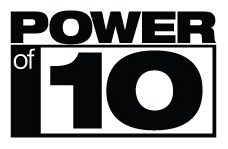Power of 10 (Australian game show)
Power of 10 was a short-lived Australian game show which is based on the original American version created by Michael Davies. The game featured contestants guessing the correct percentage range of answers to polls which have been taken from surveys, for a chance to win a million dollars.
| Power of 10 | |
|---|---|
 | |
| Created by | Michael Davies |
| Presented by | Steven Jacobs |
| Country of origin | Australia |
| Original language(s) | English |
| No. of seasons | 1 |
| No. of episodes | 2 (6 unaired) |
| Production | |
| Running time | 60 minutes (Including commercials) |
| Release | |
| Original network | Nine Network |
| Picture format | 576i (SDTV) |
| Original release | 31 March – 7 April 2008 |
The Australian version of the show premiered on Monday, 31 March 2008 at 7:30 pm on the Nine Network and was recorded in Melbourne's GTV-9 studios. The show was hosted by Today weatherman Steven Jacobs. This version followed the basic rules of the American version of the show, except with different safe levels, which are $100, $1000, $10,000, $100,000 and $1,000,000. There was no ten million-dollar question as in the U.S. version.
Despite eight episodes being filmed and six episodes never being screened, the network revealed that the game show was "indefinitely shelved" on 8 April 2008 after the second episode only pulled 200 people across all five main capital cities, losing the whole Monday Night to Channel Seven.[1]
Format
Each game consisted of two rounds. The first round featured two contestants, who tried to guess the percentages of people that said "yes" to one of various questions in a national poll. The person who guessed closest to the actual percentage earned a point. The first player to win three points in this round proceeded to the next, while the other player left the game with nothing. In the second round, the contestant had the chance to win one million Australian dollars. Contestants were asked five questions similar to those in Round One. In the first four questions, the contestants had to guess a percentage of people answering the survey which fell within a given range centered on the correct answer. The first question allowed a range of 40 percentage points (from 20% below the correct answer to 20% above), the second 30 points (15% below to 15% above), and so on - the fourth question requiring the contestant to guess the correct percentage to within plus or minus 5%. The contestant would win a stake of money for the first question correctly answered; the stake would increase by a factor of ten for each subsequent correct answer. After any question, the contestant could elect to leave the game with his or her current winnings. An incorrect answer would end the game, the contestant leaving with the amount of money they had prior to their last correct answer. The contestant had to answer the fifth question correct to the exact percentage.
For any question except the million dollar question, if a contestant guessed the actual percentage, they won an instant $1000.
Notes
- The very first contestant Kalia Best won $100. She appeared in another show called Taken Out, a dating show on Network Ten.
- In the second episode, a contestant successfully guessed the exact percentage in the qualifying round but lost 2–3.
External links
- Power of 10 on IMDb